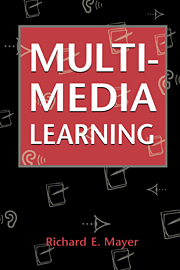Book contents
- Frontmatter
- Contents
- PREFACE
- 1 The Promise of Multimedia Learning
- 2 Multimedia Instructional Messages
- 3 A Cognitive Theory of Multimedia Learning
- 4 Multimedia Principle
- 5 Spatial Contiguity Principle
- 6 Temporal Contiguity Principle
- 7 Coherence Principle
- 8 Modality Principle
- 9 Redundancy Principle
- 10 Individual Differences Principle
- 11 Principles of Multimedia Design
- REFERENCES
- AUTHOR INDEX
- SUBJECT INDEX
6 - Temporal Contiguity Principle
- Frontmatter
- Contents
- PREFACE
- 1 The Promise of Multimedia Learning
- 2 Multimedia Instructional Messages
- 3 A Cognitive Theory of Multimedia Learning
- 4 Multimedia Principle
- 5 Spatial Contiguity Principle
- 6 Temporal Contiguity Principle
- 7 Coherence Principle
- 8 Modality Principle
- 9 Redundancy Principle
- 10 Individual Differences Principle
- 11 Principles of Multimedia Design
- REFERENCES
- AUTHOR INDEX
- SUBJECT INDEX
Summary
Temporal Contiguity Principle: Students learn better when corresponding words and pictures are presented simultaneously rather than successively.
Theoretical Rationale: When corresponding portions of narration and animation are presented at the same time, the learner is more likely to be able to hold mental representations of both in working memory at the same time, and thus the learner is more likely to be able to build mental connections between verbal and visual representations. When corresponding portions of narration and animation are separated in time, the learner is less likely to be able to hold mental representations of both in working memory at the same time and thus less likely to be able to build mental connections between verbal and visual representations. If the time between hearing a sentence and seeing the corresponding portion of animation is short, then the learner may still be able to build connections between words and pictures. However, if the learner hears a long passage and views an entire animation at separate times, then the learner is less likely to be build connections between words and pictures.
Empirical Rationale: In three of five tests, learners performed better on retention tests when corresponding portions of animation and narration were presented simultaneously rather than successively. In eight of eight tests, learners performed better on transfer tests when corresponding portions of animation and narration were presented simultaneously rather than successively.
Information
- Type
- Chapter
- Information
- Multimedia Learning , pp. 96 - 112Publisher: Cambridge University PressPrint publication year: 2001
